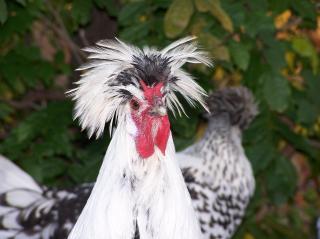For those who are not familiar with the breeds, there are some links about them.
BRABANTERS:
http://www.kippenencyclopedie.nl/php/index.php?title=Brabanter
http://www.kippengrabbelton.be/koppenb.htm
SPITZHAUBENS:
http://www.kippenencyclopedie.nl/php/index.php?title=Appenzeller_spitskuif
Yep they do come in all colors! Even they are distant cousins, the similarities are there but the two differences I see in both breeds are the beards and wattles.
When purchasing a ROOSTER from a breeder, look at the suggestions below.
If you get a Brabanter with wattles and beard, somewhere down the line it is a crossbred probably a Brabanter and Spitzhauben OR Spitzhauben and Polish cross.
If you get a Brabanter without beard and has wattles, it could be either a Golden Spitzhauben or a cross of Spitzhauben with Golden Polish.
If you get a Spitzhauben with beard, it would be a Brabanter or a cross.
If you get a Spitzhauben with beard AND wattles, same as first line.
Spitzhaubens were imported in the US about 1950's by Dr McGraw and he has sold chicks in limited quantities over the years until his death.
The Brabanters importation in the US is unknown at this time. However there were a few Canadian Brabanters but not very many. I think people later down the line mixed up the bloods of Spitzhaubens and crossed them with other breeds and worked from then on. It is a pity that hatcheries and unfocused breeders are greatly responsible for the mess. I am sure alot of us have alot of work to do to get back where they originally from. If it is all you have to work with, go for it and be prepared to cull HEAVILY and stick with the standards!
Other breeds:
http://www.kippengrabbelton.be/engels/
BRABANTERS:
http://www.kippenencyclopedie.nl/php/index.php?title=Brabanter
http://www.kippengrabbelton.be/koppenb.htm
SPITZHAUBENS:
http://www.kippenencyclopedie.nl/php/index.php?title=Appenzeller_spitskuif
Yep they do come in all colors! Even they are distant cousins, the similarities are there but the two differences I see in both breeds are the beards and wattles.
When purchasing a ROOSTER from a breeder, look at the suggestions below.
If you get a Brabanter with wattles and beard, somewhere down the line it is a crossbred probably a Brabanter and Spitzhauben OR Spitzhauben and Polish cross.
If you get a Brabanter without beard and has wattles, it could be either a Golden Spitzhauben or a cross of Spitzhauben with Golden Polish.
If you get a Spitzhauben with beard, it would be a Brabanter or a cross.
If you get a Spitzhauben with beard AND wattles, same as first line.
Spitzhaubens were imported in the US about 1950's by Dr McGraw and he has sold chicks in limited quantities over the years until his death.
The Brabanters importation in the US is unknown at this time. However there were a few Canadian Brabanters but not very many. I think people later down the line mixed up the bloods of Spitzhaubens and crossed them with other breeds and worked from then on. It is a pity that hatcheries and unfocused breeders are greatly responsible for the mess. I am sure alot of us have alot of work to do to get back where they originally from. If it is all you have to work with, go for it and be prepared to cull HEAVILY and stick with the standards!
Other breeds:
http://www.kippengrabbelton.be/engels/
Last edited:








